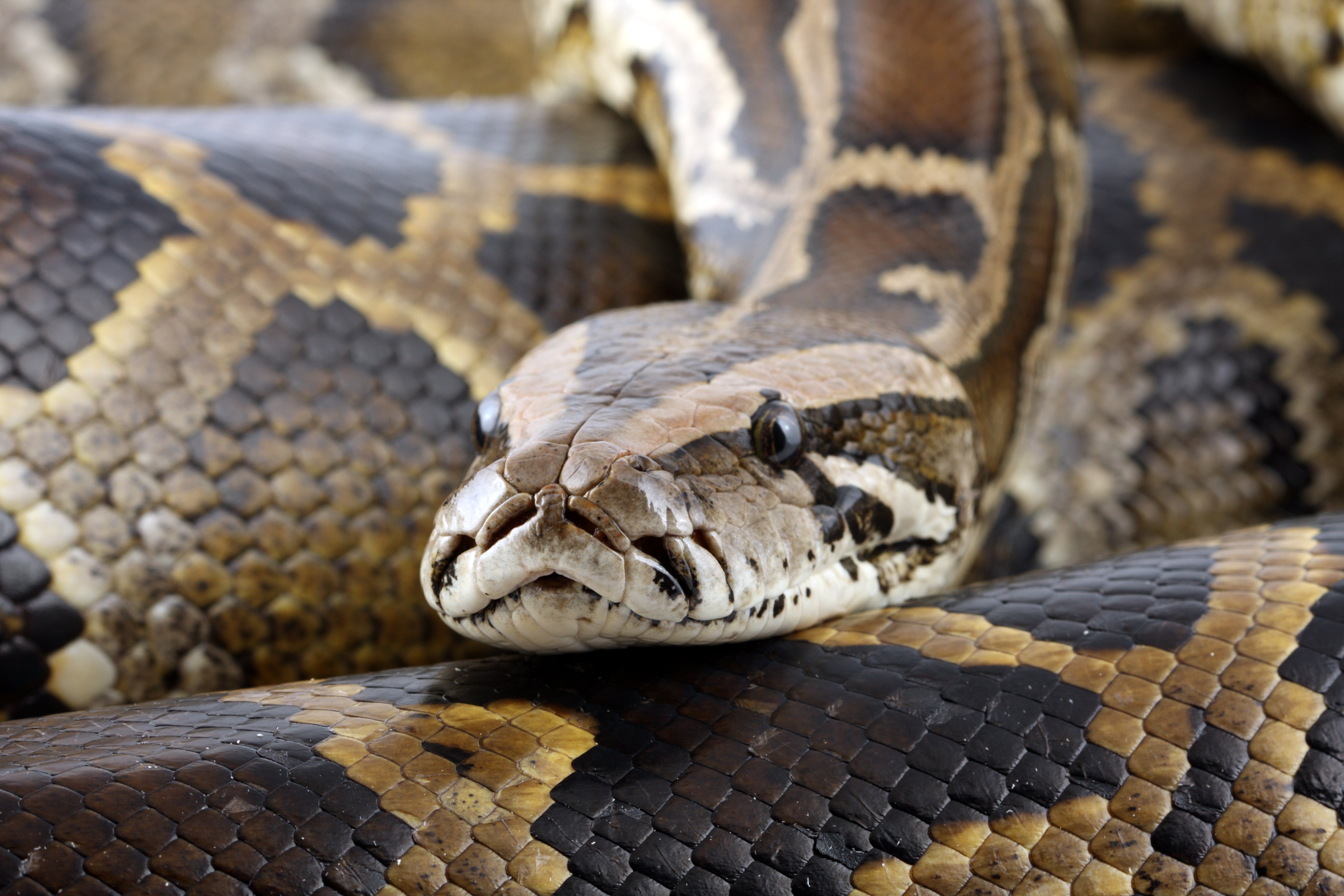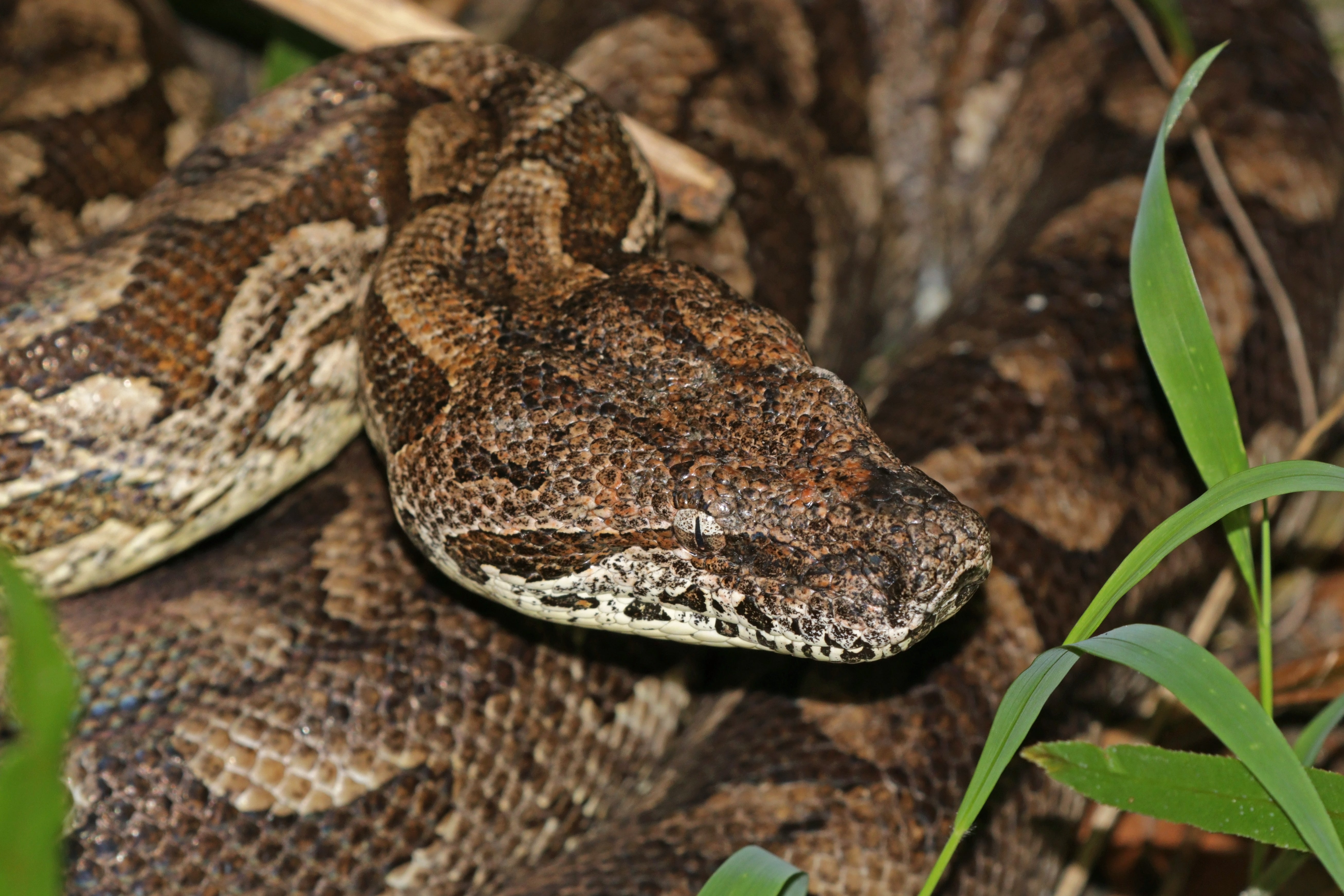Carpet pythons are a group of large semi-arboreal snakes in the Morelia genus. There are 8 different species and subspecies of carpet python:
- Morelia bredli (Centralian Carpet Python)
- Morelia imbricata (Southwestern Carpet Python)
- Morelia spilota cheynei (Jungle Carpet Python)
- Morelia spilota harrisoni (Irian Jaya Carpet Python)
- Morelia spilota mcdowelli (Coastal Carpet Python)
- Morelia spilota metcalfei (Inland Carpet Python)
- Morelia spilota spilota (Diamond Python)
- Morelia spilota variegata (Darwin Carpet Python)
These snakes can be found in New Guinea and all over most of the Australian continent. Preferred habitat varies by the species or subspecies in question — for example, M. bredli prefers more arid habitats, but M. spilota generally prefers a more tropical environment. However, they all share a love of climbing.
Like their preferred habitat, carpet pythons’ appearance varies by species/subspecies. These snakes are generally slender but muscular in build, with a teardrop-shaped head and prominent heat pits. Color is usually some combination of earthy cream, yellow, orange, red, brown, and/or black, and they usually have a more or less banded pattern, with M. spilota spilota being the exception with a more speckled appearance.
Carpet pythons are fairly popular pet snakes in the USA. Although they have a reputation for being nippy and temperamental, most experienced carpet keepers firmly assert that this reputation is unfounded, and with patience, persistent handling, and appropriate care, carpet pythons usually turn out to be calm pets. That being said, these are still intermediate-level pet reptiles. With good care, they can live up to 30+ years!
How much space do carpet pythons need?
Knowing the expected adult size of your type of carpet python is important to housing them properly. As a general rule, the length and width of a snake enclosure should add up to equal or greater than the snake’s expected adult length. Because carpet pythons are semi-arboreal, the enclosure’s height should be at least half of the snake’s expected adult length.
The average carpet python is 6.5-7’ long as an adult, so expect to build or buy an enclosure that is no smaller than 4’L x 3’W x 4’H. Of course, that’s just the bare minimum. Bigger is always better, and your snake will definitely appreciate it!
Cohabitation (keeping multiple carpet pythons in one enclosure) is not recommended, as keeping them together is likely to cause competition and stress.
Do carpet pythons need UVB?
They are able to survive without it, but it’s still best practice to provide UVB lighting for optimal health and wellbeing. Providing UVB lighting to your snake gives them all of the vitamin D that their body needs, stimulates better appetite and activity, and generally allows them to be healthier than they would be without.
The best UVB bulbs for carpet pythons are:
- Zoo Med Reptisun T5 HO 5.0
- Arcadia Forest 6%
The UVB bulb should be half the length of the enclosure and housed in a reflective fixture like the Arcadia ProT5 or Vivarium Electronics. Place this fixture close to the heat lamps, about 11-13” above the basking branch if over mesh, and 14-16” above the basking branch if not.
UVB is blocked by glass and plastic, so you can’t give your snake UVB by placing its terrarium in front of an open window. Also make sure that the fixture your UVB bulb is in does not have a clear plastic bulb cover. UVB bulbs decay over time, so don’t forget to replace your bulb every 12 months to maintain good performance.
Lights should be on for 12 hours/day.
What basking temperatures do carpet pythons need?
Like other reptiles, carpet pythons are ectotherms, which means that they need a temperature gradient in their enclosure to help them regulate their metabolism and stay healthy.
Optimum basking temperatures vary slightly based on the species/subspecies in question, but carpet pythons generally prefer:
- Basking surface temperature: 110°F
- Basking air temperature: 95-100°F
- Average ambient temperature: 80-82°F
- Cool side temperature: 75-80°F
Nighttime temps can drop as low as 68°F. In winter, the enclosure can be maintained at 5-10°F cooler than the above metrics to simulate the change in seasons. Measure air temperatures in these locations with digital probe thermometers, with the probes placed in the desired areas. Surface temperature can be measured with a temp gun.
Provide heat for your snake by imitating the sun with a cluster of halogen heat bulbs placed on one side of the enclosure, positioned over a sturdy basking branch or warm hide. Use enough bulbs to evenly heat the snake’s entire body when coiled. Do not use colored bulbs, as these are not as effective.
Light-producing heat sources should be turned off at night. But if you need supplementary heating at night to hit the right temps, use a ceramic heat emitter or radiant heat panel connected to a thermostat.
What humidity levels do carpet pythons need?
Generally speaking, carpet pythons do well between 40-60% average humidity, although M. bredli prefers drier conditions between 30-50%.
Measure humidity levels in the enclosure with a digital hygrometer placed in the middle of the enclosure. It’s also helpful to install a humid hide for your snake somewhere on the cool side of the enclosure, lined with moistened sphagnum moss. Always having a humid retreat is essential!
Mist your snake’s enclosure with a sprayer first thing in the morning, and again at night if needed. If you need more humidity, installing a cool mist humidifier connected to a hygrostat can be helpful.
What substrate is good for carpet pythons?
Substrate is important for cushioning your snake’s body and helping maintain healthy humidity levels. As an added perk, it also tends to make the enclosure more attractive. We recommend the following substrates for carpet pythons:
Layering clean, chemical-free leaf litter on top of the substrate can help with humidity, and also provides extra cover for your snake to hide in as desired.
Substrate should be at least 3” deep and completely replaced every 3-4 months. Remove poop and urates daily, along with contaminated substrate.
What décor can you use in a carpet python terrarium?
It’s terribly boring for a snake to be stuck in an enclosure with nothing in it except substrate, a branch, and a water bowl. It doesn’t matter how big the enclosure is if you don’t put things in it for your pet to use and interact with.
Here are some décor ideas for enriching your python’s environment:
Whatever you choose to use, make sure that the snake has plenty of cover to hide in so it can feel secure in its environment.
What do carpet pythons eat?
Like other snakes, carpet pythons are carnivores, which means that they need to eat whole animal prey in order to get the nutrition that they need. Here is a rough feeding schedule based on snake age:
- Hatchling — every 10-14 days
- Juvenile — every 2 weeks
- Adult — every 3-4 weeks
Prey items should be around 10% of your snake’s weight and no bigger than 1.5x the snake’s widest point. Feeder options include mice, young rats, African soft-furs, gerbils, chicks, and quail. Variety is the key to a balanced diet! However, do note that carpet pythons seem to have a distinct preference for mice and birds, which are smaller prey items and may require offering multiple prey items per feeding or feeding more frequently.
Although live prey can be used, it’s safest and most humane to use frozen instead. Prey should be thawed in a plastic bag in warm water to approximately 100°F before offering with a pair of soft-tipped tweezers.
Supplements
Snakes can survive without vitamin or mineral supplements, but occasionally using them can help prevent nutritional deficiencies and optimize your pet’s health. We recommend Repashy Calcium Plus LoD.
Water
Make sure to provide a tub or bowl of water large enough to accommodate the snake’s entire body. Keep the water in this tub clean at all times, and scrub with animal-safe disinfectant once a week.
Do carpet pythons like to be handled?
Few reptiles actually “like” to be held, but carpet pythons generally tolerate human interaction well as adults. Carpet pythons have a reputation for being “nippy” and “aggressive,” but that is a myth. They can be defensive as babies, but generally grow into calm adults. That being said, there are still some basic rules for handling snakes:
Wait at least 2 weeks before attempting to handle a new snake. Babies and juveniles tend to be more nervous and defensive than adults. Be gentle, and pick up the snake from below rather than from above. Support as much of its body as possible, and NEVER pick a carpet python up by its tail! Keep handling sessions brief at first, and always end them on a positive note, with the snake acting calm.
*This care sheet contains only very basic information. Although it’s a good introduction, please do further research with high-quality sources to obtain additional information on caring for this species.




Leave a comment
This site is protected by hCaptcha and the hCaptcha Privacy Policy and Terms of Service apply.